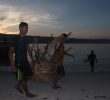The peasant group Kilusang Magbubukid sa Pilipinas (KMP) said that the high amortization payment for lands acquired under CARP defeats the purpose of land reform, which is supposed to even out the largely unequal distribution of land and resources in the country. Most of the farmers could not afford the high amortization payment, said Celso Pojas, KMP spokesperson for Southern Mindanao.
But Inson explained that DAR has to come up with that scheme as the government is buying private agricultural lands, or lands owned by private land owners, for distribution to the farmers. In turn, farmers are made to pay amortization within the period of 30 years. Failure to pay for the amortization in three consecutive terms will make them forfeit the land, he said.
“The real essence of agrarian reform is to break the monopoly of land by the few. We learned in our Philippine history that only 10 per cent controls the landownership in this country,” Inson said.
Inson also explained that government needed funds to spend for the increased productivity of farmers.
“How can the government recover the money it spends for buying the land from private landowners? Awarding the land for free is a good idea but then, people tend to value more what they buy than what is freely given to them,” he explained.
Only the public agricultural lands, owned by the government, are distributed for free, Inson said.
Among the public lands subjected to land reform, are government resettlement areas, lands administered by National Livelihood Program and a portion of the Davao Penal Colony (Dapecol).
He said there are farmers who can even afford to sell their lands after they bought it.
But Pojas said government support services for farmers are indeed lacking. “Not everyone is reached by government support services,” he said.
DAR has set up agrarian reform communities (ARCs) as the convergence points of government’s support services such as infrastructure like farm -to- market roads, rural water system’ agricultural developments like livestock, seedlings as well as trainings for the farmers. In Southern Mindanao, DAR has listed 103 ARC’s in 371 barangays in 54 different towns, where government has been implementing projects, tapping either its own fund or foreign sources. Some of the agrarian reform beneficiaries have also opted for a “leaseback” arrangement with former landowners or a new corporation, which ironically allows them to work as hired workers and tillers while leasing back to their former landowners the land supposedly awarded to them.
KMP hits CARP for its failure to cover vast landholdings of big landlords in Davao like the Floreindo’s, Lagdameo’s, Ayala’s and the Dizon’s under the government’s land reform program. Inson said these landholdings are still target for distribution; just like the landholdings of the Sarmiento’s in Monkayo, the Ayala’s in Hagonoy, Sta. Maria and Malita towns of Davao del Sur.
He said the landholdings of Rabat and Ricamora also in Davao Oriental are also in the process for distribution. A portion of the Floirendo-owned Tadeco banana plantation is also covered by CARP. Others still have pending cases and being contested under CARP.
Land Reform









